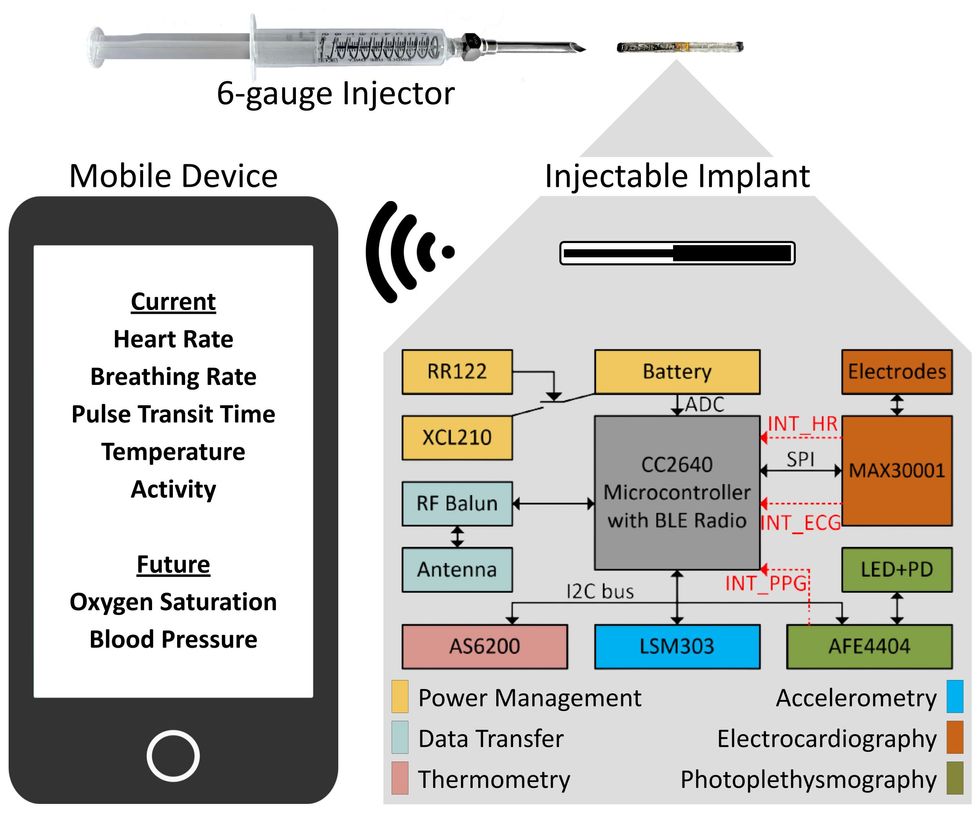This article is part of our exclusive IEEE Journal Watch series in partnership with IEEE Xplore.
Around the world, many pets and working animals are microchipped. It’s a simple process: A tiny transponder with an identification number is enclosed in a rice-grain-sized cylinder and injected under the skin, so that if an animal is lost it can be identified.
But electronic chips can do a lot more than hold an ID number. What if we could track a lost animal’s location? Monitor a dog’s heart rate after a medical procedure? Track the breathing rates of cattle and their calves on a livestock farm?
Injectable activity- and health-tracking sensors are indeed doable—and they could unlock novel insights and safety measures for veterinarians, farmers, animal researchers and owners of working animals and pets, according to a new study published in IEEE Sensors Journalon 22 February.
A team from North Carolina State University used off-the-shelf materials to create what they say is “the most advanced multimodal and minimally invasive injectable sensor system for animals to wirelessly monitor several of their physiological indicators and activity patterns.”
In the study, the implant provided real-time measurement of heart rate, breathing rate, movement, and temperature, along with capabilities to track blood pressure and oxygen saturation in future work.
“Animal scientists in particular tell us: We want one of these yesterday“ —Alper Bozkurt, NC State University
“Researchers use implantables already out there to track animals in studies, but they’re cumbersome: You need to put the animal under anesthesia and perform a surgery to implant this larger device,” says Alper Bozkurt, codirector of the National Science Foundation’s Center for Advanced Self-Powered Systems of Integrated Sensors and Technologies (ASSIST Center) and NC State’s Institute of Connected Sensor Systems (IConS). “We asked, why not use a much simpler and cheaper process like the microchip implant that’s done at just about every veterinary clinic?”
Bozkurt compares the injectable to a smartwatch that humans wear to track activity and basic vital statistics. “There’s a lot of little electronics behind that glass watch face; we took much of it and put it inside something really small.”
Health Tracker in a 6-Gauge Needle
Bozkurt and his colleagues Parvez Ahmmed and James Reynolds created the device in part using a commercially available system-on-a-chip. Their injectable chip system includes multiple physiological sensors, front-end circuits, a microcontroller with a wireless radio system to send measurements, Bluetooth low-energy capability, and a rechargeable battery.
The sensors leverage several different modalities: An electrocardiography sensor measures heart rate; an inertial measurement unit tracks movement and breathing rate; thermometry shows temperature. (The researchers plan to demonstrate blood-pressure and oxygen-saturation tracking in future work through a multiwavelength photoplethysmography sensor that is already part of the system.)

The researchers encapsulated the chip system in biomedical epoxy and a biocompatible synthetic polymer for insulation, then added electrically conductive epoxy at the tip to act as electrodes. This fit into 6-gauge surgical needles, which they used to inject the chip systems into both anesthetized rats and freely moving rats.
The microchip can send data from the sensors to a remote receiver within 3 meters, and the battery can last two to three months between recharges. Heart-rate and breathing-rate measurements were within close range of existing gold standards.
The team designed the system with both a biomedical epoxy and a synthetic polymer layer, so the device could be extracted and reused. “Say we use it with an animal, and a month or two later we can dissolve the outer polymer layer, recharge the battery, and encapsulate it again to produce another implant,” Ahmmed says.
Biometrics in a Smaller Package
Looking ahead, the team concluded they’ll need to build their own specialized application specific integrated circuits (ASICs) to shrink the injectable system down from 6-gauge-needle size (about 4 millimeters) to the 12- or 15-gauge (1.4–2.2 mm) needles currently used in traditional microchipping. (They have also experimented with 3D-printing electrodes using novel ceramic-based printing processes.)
“You always want to design something that’s very analogous to what already exists: the same skills, procedures, and look as a regular microchip,” Reynolds says. “But that size is a very tiny diameter so it’s been quite the technical challenge.”
Despite the challenges, the team did manage to create a smaller, battery-free version of the system that is detailed in a 4 March paper in IEEE Transactions on Biomedical Circuits and Systems.
Reynolds, who comes from a long line of farmers, noted that the injectable has several agricultural applications: a sharp increase in heart rate could alert a farmer to a livestock animal experiencing pain from, say, a fractured bone, while other vital signs could help stop a disease among herd animals before it spreads. Veterinary researchers could also use the device to monitor endangered species, on whom they cannot perform surgery to implant a large tracker, he notes.
Working animals and pets can also benefit, says Jane Russenberger, cofounder of the International Working Dog Registry, an online registry where working-dog owners can add, edit, and view electronically stored records.
Data from the injectable “could be analyzed to help with predicting the dog’s likelihood of success in a particular type of work or placement with a particular type of handler,” Russenberger says. Examples, she adds, include pets being assessed for adoption, animals offered to sale for government agencies for use in detection work, and testing the impact of training classes, socialization, and other enrichment activities for pets.
With potential applications from pet ownership, to veterinary research and practice, to farming, to working animals, Bozkurt wants to translate this system to the market and says industry interest is high.
“I can’t share the names, but I can say we have a number of companies interested,” Bozkurt says. “There are so many applications with various end users, and animal scientists in particular tell us: We want one of these yesterday.”
- “Dog Cam” Trains Computer Vision Software for Robot Dogs - IEEE ... ›
- Wearable Sensor Tracks How Much You Scratch - IEEE Spectrum ›
- Energy Harvesting for Wearable Technology Steps Up ›
Julianne Pepitone is a freelance journalist who reports via text, video, and television. She spent years on staff at CNN Business and then at NBC News, covering consumer tech, cybersecurity, and business. Now a freelancer, she works with an eclectic roster of clients. Beyond Spectrum, CNN, and NBC, her bylines can also be found at HGTV Magazine, Memorial Sloan Kettering, NYMag.com, Glassdoor, Popular Mechanics, Cosmopolitan, Town & Country, Thrillist, MagnifyMoney, The Village Voice, and more.



